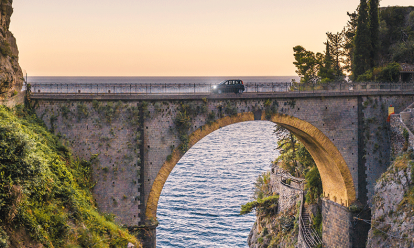Driving advice for every country in Europe
From required documents to European breakdown cover and vehicle accessories, find all the up-to-date driving laws and advice for every country in Europe in our travel guides.
Driving in Luxembourg

But if you’re planning a car journey to Luxembourg, it’s essential you’re fully prepared ahead of time as driving there has many differences to the UK.
To make your trip to the Continent as safe and effortless as possible, we’ve put together a guide to everything you need to know before you go, from required documents to rules of the road.
Driving a rented vehicle? Jump to the advice for driving a hire car in Luxembourg section.
RAC European Breakdown Cover (Basic and Comprehensive) provides a wide range of benefits should you breakdown in Luxembourg to ensure you stay safe.
To supplement this, RAC also offers travel insurance. Cover will include medical expenses, baggage, personal money and belongings, among many other benefits.
Need short-term insurance for your vehicle? Our temporary car cover is perfect if you're looking for flexible insurance for between 1 hour and 30 days.

European Breakdown Cover
Get covered when driving in Europe for just £4.17 a day*.
*Price is based on European Comprehensive breakdown cover for a 14 day trip, in a vehicle up to 1 year old, travelling in zone 1.

Things to take when driving in Luxembourg

Documents for driving in Luxembourg
- A valid, full UK driving licence (you must also be 18 or over)
- Your motor insurance certificate (ensure your car is covered by third-party insurance recognised in Luxembourg. This is the legal minimum cover for residents and visitors, so check with your provider before you travel)
- The V5 registration document for your own car or the hire car paperwork for a rental
Do I need a GB or UK sticker for driving in Luxembourg?
From 28th September 2021, the distinguishing mark (or national identifier) displayed on vehicles registered in the United Kingdom that are driven abroad will change from GB to UK.
This means that vehicles registered in the UK must display the letters “UK” when driven in Luxembourg.
The identifier can be incorporated in vehicle number plates (along with the Union Flag) or as a separate sticker. Note that vehicles featuring the letters GB together with the Council of Europe golden stars are no longer valid for driving abroad.
If your vehicle does not have the UK identifier within the number plate, you will require a UK sticker when driving in Italy. GB stickers will no longer be valid from the end of September.
Do I need an insurance green card?
From 2nd August 2021, drivers will no longer require an insurance green card for taking their vehicles to Luxembourg.
ETIAS – 2025
ETIAS stands for the European Travel Information and Authorisation System. It is a visa program for visitors who don’t need a Schengen visa, who want to travel to the European Union and a few other European countries.
Visitors who purchase an ETIAS will be able to enter the 26 member states of the Schengen Zone as well as Bulgaria, Croatia, Cyprus, and Romania.
This will be launching in 2025. Learn more about ETIAS here.
Driving in Luxembourg packing checklist
Aside from the documents above, there are some legally-required items you must bring with you to drive in Luxembourg.
Unless your headlights can be adjusted, it's a legal requirement to carry headlamp converters (stickers for your headlights when driving on the right, so your lights don't dazzle motorists coming the other way).
A warning triangle is also compulsory to carry in vehicles in case of a breakdown.
It's also recommended to have:
- Spare bulbs for your car's external lights
- A fire extinguisher
- A first-aid kit
- A reflective jacket
- A Camping Card International to give you additional proof of identity, third-party liability insurance, plus discounts at a wide range of campsites and tourist attractions
You can pick up all the car kit you need from RAC Shop.
Is there anything that I shouldn’t take with me?
Be aware that you cannot take the following with you into Luxembourg:
- meat or products containing meat
- milk or dairy products
You cannot take the following unless you pay to have them inspected before you leave and get a ‘phytosanitary certificate’:
- fresh fruit (apart from bananas, coconuts, dates, pineapples and durians)
- vegetables
- plants
- plant products
Rules of the road in Luxembourg
- Wear a crash helmet if you're riding a motorcycle
- In Luxembourg, you drive on the right and overtake on the left. Buses, including school buses, have right of way when pulling out. On steep roads, traffic driving uphill has priority
- If you're in a built-up area, you can only use your horn in cases of extreme danger
- The use of dipped headlights during the day is recommended for all vehicles, while your rear red fog lights may only be used when visibility is reduced to 50 metres
- If you're caught committing a motoring offence while driving through Luxembourg, you could be given an on-the-spot fine of up to €145
- Seat belts should be worn in all seats where a belt is available
- Children under the age of 3 must use an appropriate seat restraint. Children weighing over 36kg can use the lap part of an adult seat belt. Children up to 150cm tall can't travel in the front seat without a suitable seat restraint
- The drink-drive limit is 0.05%. For professional drivers and novice drivers with less than 2 years' experience, the limit is 0.02%. Anyone suspected of driving under the influence might be subjected to a breath test
Speed limts in Luxembourg
The speed limit is 50km/h in built-up areas and 90km/h on open roads. On motorways, it’s 130km/h – reduced to 110 km/h in rain or snow
Other things you should know when driving in Luxembourg

- You won't have to pay motorway tolls to drive in Luxembourg
- Unleaded petrol and diesel are readily available, as is LPG. Many petrol stations have automatic pumps which operate with a bank card or credit card
- There are motorway service areas situated at Capellen on the Arlon motorway and near Bettenbourg on the A3 motorway in the direction of Thionville/Metz
- You will usually be charged to park in towns, either by parking meters, tickets or parking discs. Wheel clamps are used throughout Luxembourg, and cars that are causing an obstruction may be removed and impounded
- It’s easy to cross into neighbouring countries without realising it. Keep your passport with you for identification
In an emergency
112 - Here's a really important bit of knowledge; you can dial 112 from anywhere in Europe and an operator will connect you to an emergency service in the country you're visiting.
Operators can answer your call in their native language, English or French.
Breaking down in Luxmbourg
RAC offers great-value, flexible RAC European breakdown cover tailored to meet your needs. We also offer comprehensive travel insurance, including cover for medical expenses, baggage, personal money and belongings.
Driving a hire car in Luxembourg
Not all of the information in the guide above will be relevant to those looking to rent a hire car in Luxembourg.
Though it might be a good idea to read through everything anyway, here are the most important things to know for drivers of rental vehicles:
Rental information
- The minimum age to hire a car is 21
- You need a full, valid UK driving licence and usually a second proof of ID (passport)
- Some car rental companies ask that you have held your licence for a minimum term of 1 year
- Some companies require you to use a credit card for deposit
- You may not be able to drive outside of Luxembourg unless planned in advance - check with your hire company first
- Make sure you get car hire excess insurance before your trip to protect yourself from unexpected costs. It's almost always cheaper to do this with a separate insurer and in advance
Hire car driving tips
- Luxembourgers drive on the right and overtake on the left - the opposite to the UK
- The national speed limit on Luxembourgish motorways is 130km/h (reduced to 110km/h in rain or snow). On a main road outside a built-up area it's 90 km/h. For built-up areas it’s 50km/h
- Dial 112 in an emergency
- It’s compulsory to wear seat belts in the front and rear seats
- The blood alcohol content limit for drivers of private vehicles is 0.05%. That's lower than the 0.08% in England Wales and Northern Ireland, but the same as Scotland.


Driving in Luxembourg FAQs
- Is it safe to drive in Luxembourg?
Yes, the road network in Luxembourg is well maintained, with comfortable driving conditions all year round. There are roads that offer easy access to neighbouring countries, although sometimes you may not even realise you’ve crossed the border!
Some people say getting around Luxembourg can be a little confusing as it has several hills that may cause you to lose your bearings, but generally it’s very straightforward.
As with driving in any foreign country, it’s important to familiarise yourself with the law to ensure you stay safe on the roads.
- Can you drive in Luxembourg with a UK licence?
Yes. You can legally drive in Luxembourg with a full and valid UK driving licence. In addition to this, International Driving Permits are recognised but not required.
- Do I need a green card to drive in Luxembourg?
Like the UK, Luxembourg is a member of the Green Card System, a Europe-wide scheme that allows countries to recognise foreign vehicle insurance policies of visiting motorists.
UK motorists are no longer required to carry a green card to drive in Luxembourg, but you should check that your policy will cover you in all countries you plan to visit before setting off.
- What side of the road do they drive on in Luxembourg?
As in the vast majority of continental Europe, motorists drive on the right-hand side of the road in Luxembourg.
- Do I need a GB/UK sticker for Luxembourg?
You will need to display a UK sticker on the rear of your car. GB stickers have been discontinued.
- Can I drive my car in Luxembourg?
Yes, although before driving your car to Luxembourg, it’s important you have all the necessary documents to stay safe and legal on the roads, including sufficient insurance cover.
You should also ensure you have all the required items needed for your journey in Luxembourg (such as a warning triangle and reflective jacket) as well as for any other country you’re planning to drive through.
- How do I drive to Luxembourg?
you’ll need to take your car across the Channel to Calais on either the Eurotunnel from Folkestone or a ferry from Dover.
From Calais, your quickest option is to take the A25 motorway via Lille, then head south through the Belgian city of Namur along the E411 to Luxembourg. The drive from Calais to Luxembourg City takes around five hours non-stop.
- What age can you start driving in Luxembourg?
To legally drive in Luxembourg, you must be 18 years or older and in possession of a full valid driving licence.
- Do I need winter tyres to drive in Luxembourg?
In winter, it’s a legal requirement to drive with winter tyres on, regardless of which country your car is registered in. There is no set date for when this law kicks in, it is simply defined by ‘when there are wintry conditions’ such as black ice, packed snow, slush, ice or frost. This can be confusing so it’s best to have winter tyres fitted before your trip, if you are travelling in winter, regardless of the weather.
Snow chains can be used if ice and snow are expected, and you’re allowed to use spiked tyres between 1 December and 31 March.
- Are there toll roads in Luxembourg?
Motorways in Luxembourg are toll-free for private vehicles, but trucks and lorries must have a Eurovignette.

European Breakdown Cover
Get covered when driving in Europe for just £4.17 a day*.
*Price is based on European Comprehensive breakdown cover for a 14 day trip, in a vehicle up to 1 year old, travelling in zone 1.

UK Government travel advice
British Embassy Luxembourg
5, Boulevard Joseph II
L-1840 Luxembourg
Luxembourg
Email: [email protected]
Telephone: (+352) 22 98 64
Fax: (+352) 22 98 67
Fuel
Fuel prices in Luxembourg can be found in our up-to-date European fuel prices page.
